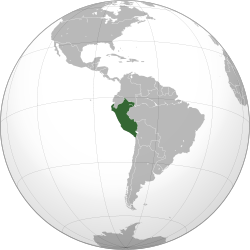Communal Land Titling At A Standstill In Peru
By Tierramerica
By Milagros Salazar
The titling of the lands of indigenous and peasant communities has been at a practical standstill for two years, with many of the corresponding files lost or incomplete. But the promotion of foreign investment is moving full steam ahead in the same regions.
“Without land titles, people are forced to move from one place to another, and have even been the target of death threats. Some have been able to gain ownership of their farms, but in other cases, the companies have moved in,” said Valbina Miguel Toribia, a member of the Yanesha indigenous community in the central Amazonian region of Pasco. “This means they have no choice but to fight for their own piece of land,” she told Tierramérica.

Miguel Toribia tackled numerous conflicts of this kind when she was the leader of the Federation of Yanesha Native Communities, and today she is a witness to similar struggles in neighboring communities.
This situation is repeated throughout Peru, because the titling of the lands of communities who occupy more than 27 percent of the country’s total area has slowed down significantly in recent years.
Between 2006 and 2010, while Alan García was in office, a mere 19 land titles were granted, in addition to 23 territorial expansions, according to the Agency for the Formalization of Informal Land Ownership (COFOPRI).
Progress has been slow for communities in the Andes and on the coast, but the situation is much more chaotic in the Amazon region, where gas, oil and infrastructure investments and projects are concentrated.
Peru, an Andean and Amazonian country with a Pacific Ocean coast, is a world mining power and has oil and gas reserves as well. It is also a multi-ethnic nation of 30 million inhabitants, 31 percent of whom are indigenous.
Since 2010, when the government transferred COFOPRI’s land titling function to regional administrations, the process has practically ground to a halt.
While 24 of the country’s 26 regional governments can now officially exercise this function, they have not been provided with the corresponding files or complete information by COFOPRI, which means there is little they can do, sources from the Secretariat of Decentralization told Tierramérica.
Moreover, there is no central government institution to regulate the process, and in various cases, the necessary resources and trained personnel are also lacking, Alicia Abanto, assistant director for the Environment, Public Services and Indigenous Peoples at the Ombudsman’s Office, told Tierramérica.
As of September 2010, according to official figures, 6,069 peasant communities in the Andes and on the coast and 1,649 indigenous communities in the Amazon region had been registered and recognized. Of this total, 16 percent had still not been granted land titles.
However, sources at the non-governmental Institute of the Common Good (IBC) maintain that the real number of these communities is much greater, and that in the Amazon rainforest, the actual number of communities without land titles could be up to four times greater than the government’s estimate.
One of the main problems is the lack of systematized and updated information “to know where the communities are and subsequently implement actions and policies,” Eduardo Nayap, a lawmaker and member of the Awajún ethnic group, told Tierramérica. “We indigenous people are not counted in the statistics,” he said.
To fill this void, in September the IBC released the Directory of Native Communities of the Peruvian Amazon, based on official files from the registration and titling of lands between February 1975 and April 2012. During this time, 1,807 communities were officially registered, while 663 have been carrying out the procedures to receive land titles for more than a decade.
“There is no state policy that establishes the procedure and mechanism for land titling, which places these communities in a fragile situation in the face of private investments (on communal lands),” said lawyer Pedro Castillo of the Peruvian Center for Social Studies (CEPES), one of 18 organizations participating in the Secure Territories for the Communities of Peru campaign.
As of October 2010, more than 60 percent of the country’s Amazon region was covered by oil and gas concessions, according to official figures compiled by the IBC’s Information System on Native Communities of the Peruvian Amazon.
In some parts of the Andes, the situation is similar. For example, mining concessions have been granted for 47.3 percent of the Cajamarca region in northwest Peru, according to a report prepared by the non-governmental organization CooperAcción based on official statistics.
Given the continued lack of progress in communal land titling under the current administration of President Ollanta Humala, the Ombudsman’s Office has formulated a series of recommendations for the institutions involved.
In meetings held up until September with officials from 10 regional governments, it was determined that there are “serious problems with the documentation required, because of files that are incomplete or non-existent,” Ombudsman’s Office representative Mayra Quicaño told Tierramérica.
Almost half of peasant community lands have also not been incorporated into a central registry database. The maps and descriptive notes are scattered among the offices of regional governments, public registries and other institutions, reported the Ombudsman’s Office.
In the Amazon region, the legal framework is over 20 years old and does not reflect the current reality. As a result, conflicts over the lack of communal land titles continue to simmer.
The Ombudsman’s Office told Tierramérica that in June, the various institutions involved reported that a draft decree is being studied that would establish the Ministry of Agriculture as the body responsible for overseeing the land titling process, a move that is viewed positively by both the Ombudsman and CEPES representative Castillo.
However, sources at the Secretariat of Decentralization revealed that the adoption of the decree has been halted by a lack of agreement between the legal departments of the Ministry of Housing, to which COFOPRI is attached, and the Ministry of Agriculture.
